15 Ways How Jewelry Stores can Increase their Conversions

If you’re running a jewelry store, you probably already know this: converting casual visitors into buyers can be a challenge.
In fact, the average eCommerce conversion rate for high-value jewelry stores is often less than 1%. That means for every 100 visitors, only one might walk away with one of your precious pieces.
But what if you could change that?
Jewelry isn’t just about buying something beautiful—it’s an emotional purchase, often tied to memories, milestones, and moments that last a lifetime. So, how do you bridge that gap between admiration and action? How do you turn those “just looking” shoppers into loyal, paying customers?
To answer that we’ve come up with 15 practical CRO strategies that can help your jewelry store stand out, build trust, and drive more conversions.
So, let’s get started!
How can Jewelry Stores Increase their Conversions?
Here are the 15 CRO strategies for Online Jewelry Stores:
- Show Off Detailed Specifications or Certifications
- Highlight Social Proof with UGC
- Present your Limited-Editions or Exclusive Selections
- Let Customers Try On Jewelry Virtually
- Help them with Jewelry Size Guide or Ring Sizer
- Let Them Personalize Their Jewelry
- Wow Them with High-Quality 360-Degree Product Views
- Share Jewelry Care & Maintenance Tips
- Offer Various Custom Packaging Options
- Feature Seasonal or Occasion-Specific Collections
- Promote Ethical Sourcing & Sustainability
- Curate Gift Sets and Bundles
- Incorporate Flexible Payment Options
- Offer Extended Warranty Programs
- Show Approx. When the Order will be Delivered
Let’s understand how to implement these strategies one-by-one.
1. Show Off Detailed Specifications or Certifications
When it comes to purchasing jewelry—especially high-value pieces like diamond rings or gold necklaces—customers need assurance that they’re making a wise investment. Providing detailed specifications—like the type of metal, carat weight, stone clarity, and cut—not only helps shoppers understand what they’re getting but also reassures them of the quality and value of their purchase.
But here’s where it gets even more important: Certifications! Would you buy a diamond ring without knowing its authenticity? Probably not, and neither would your customers. Displaying third-party certifications, especially for diamonds or precious stones, goes a long way in earning customer trust.
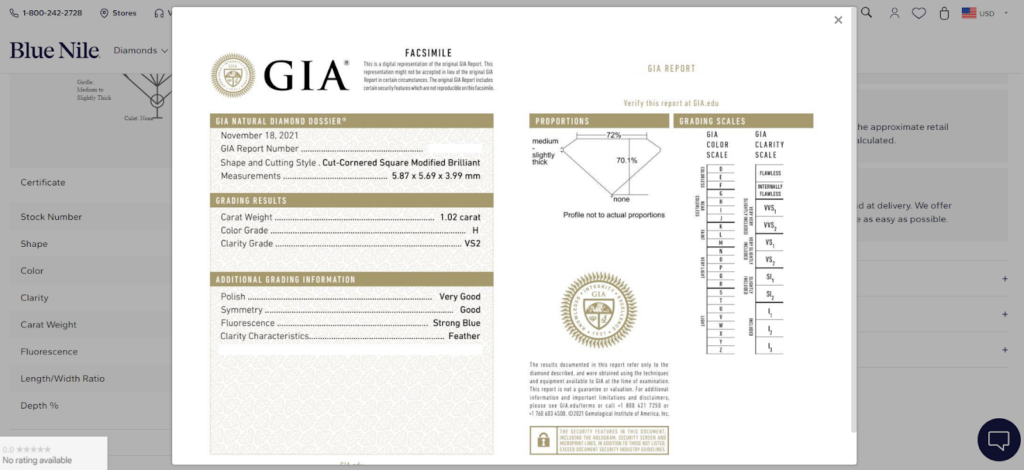
Whether it’s a GIA (Gemological Institute of America) certification for diamonds or an ethical sourcing guarantee, these credentials give customers the confidence that they’re buying an authentic, high-quality product.
Let’s take CaratLane, a popular online jewelry retailer, as an example. See how beautifully they have presented the information on metal purity, stone quality, and even certifications for product authenticity.
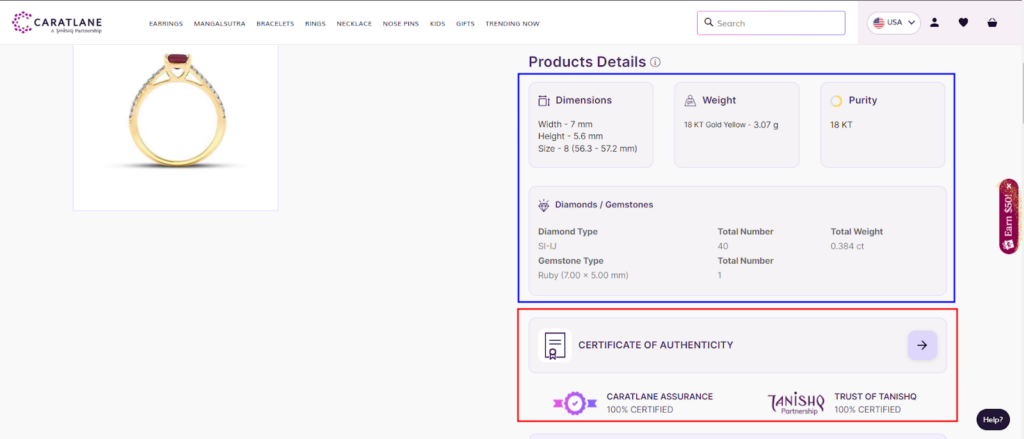
Key Takeaways:
- Ensure that every piece of jewelry you sell has a detailed product description covering everything from material type to gemstone grade.
- Include certifications, especially for high-value items like diamonds, as they build credibility and trust.
- Use easy-to-read charts or visuals to simplify technical details, helping customers quickly understand the quality of what they’re buying.
2. Highlight Social Proof with UGC
Product reviews are commonly used by everyone, and with the availability of tools that generate fake reviews, shoppers don’t consider those text reviews anymore.
That’s why we recommend placing User-generated content (UGC) alongside product reviews to regain their trust. UGC shows real people wearing your jewelry and makes your brand feel more authentic. Plus, studies show that UGC can increase conversion rates by up to 102.4%!
BRUNA The Label, a popular jewelry brand, creates a vibrant gallery of real people flaunting their pieces, which they prominently feature on their website.
For more inspiration, check out how other eCommerce brands are using user-generated content – Top UGC examples!
Key Takeaways:
- Encourage your customers to share their experiences and photos on social media, perhaps with a branded hashtag.
- Feature UGC prominently on your product pages or homepage to provide potential buyers with real-life examples of how your jewelry looks.
3. Present your Limited-Editions or Exclusive Selections
“Only a few of those pieces exist in the world”.
Women love exclusivity, and there will always be a stronger desire for a unique piece over something that’s mass-produced. Limited-edition or exclusive selections not only drive attention but also create a sense of urgency and prestige that can drive conversions.
So, how can the brands create this desire in your jewelry store?
Tiffany & Co. is the best example here. Their Tiffany Blue Book Collection features limited-edition pieces that are often released in small quantities, each accompanied by exquisite craftsmanship and unique designs.
Key Takeaways:
- Develop limited-edition pieces that reflect seasonal trends, special events, or collaborations with artists. When customers know they’re purchasing something that others might not have, it elevates the experience.
- Offer exclusive access to special collections for loyal customers or members of your mailing list.
- Each exclusive piece should come with a story—what inspired it, the craftsmanship behind it, or the limited number available.
4. Let Customers Try On Jewelry Virtually
You may wonder, “Is this really necessary for a jewelry website?”. Absolutely!
With virtual try-on technology, you give your customers the ability to “wear” your jewelry from the comfort of their own homes. By simply using their phone or computer camera, they can see how a necklace drapes on their neck or how a pair of earrings complements their face.
Offering virtual try-ons can bridge the gap between window shopping and making a confident purchase decision.
A study by Shopify found that products using augmented reality and virtual try-ons see a 94% higher conversion rate than those that don’t. That’s a staggering difference, and it shows that shoppers are more likely to buy when they can virtually experience your product.
See how Tiffany & Co. has nailed it. When you visit their product pages on your smartphone, some jewelry items can be virtually “tried on”.
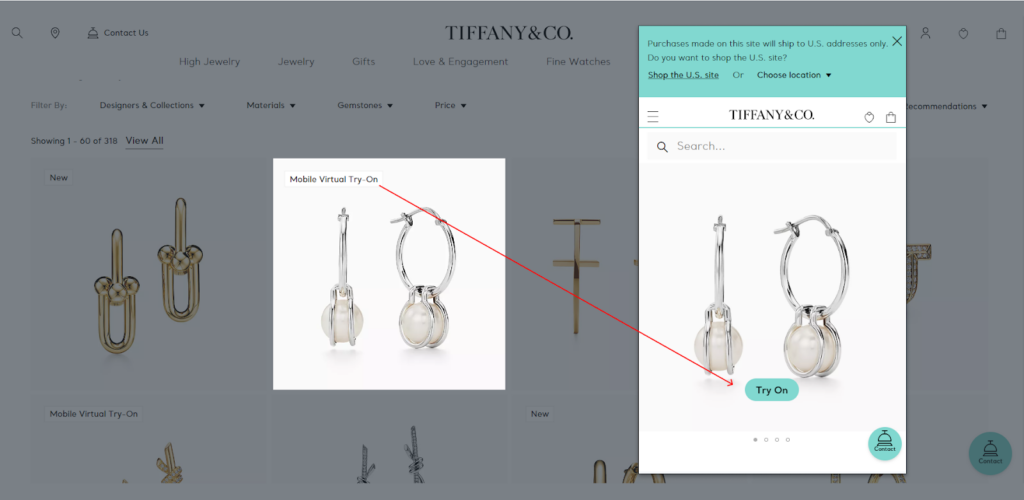
Suppose you’re browsing a stunning pair of earrings or an iconic Tiffany ring, and within seconds, you can see exactly how it would look on you—all through your phone’s camera. This interactive experience not only builds excitement but also instills confidence in your customers’ buying decisions.
After all, they’ve seen it on themselves, so they know it’s a perfect fit.
Key Takeaways:
- If you don’t already have this feature, consider adding one. There are various third-party tools you can integrate with your website to provide an interactive experience.
- Make sure your virtual try-on feature is front on each product page. Call attention to it, so customers don’t miss the opportunity to try before they buy.
5. Help them with Jewelry Size Guide or Ring Sizer
Most of the fear of buying the wrong size and then dealing with returns or resizing stops them from making that final click.
You can make the decision easy for them by providing a size chart. By helping your customers find the perfect fit, you’re removing a huge barrier to purchase and showing them that their experience with your brand will be smooth from start to finish.
Take inspiration from brands like Mejuri Inc., who make sizing easy by offering an online ring size guide that includes sizes for different countries. Not only this, but they also help shoppers measure their finger size.
Key Takeaways:
- Create a simple, visual guide that explains how to measure for rings, bracelets, and necklaces.
- Include both written instructions and easy-to-read charts with standard and international sizes.
- Let your customers download a PDF they can print at home to accurately measure their ring size.
- Many shoppers browse on their phones, so ensure your size guide is optimized for mobile users.
6. Let Them Personalize Their Jewelry
Jewelry is deeply personal.
It often marks life’s most important moments—engagements, anniversaries, birthdays, or simply a treat for oneself. So, why not take a step further by letting your customers personalize their jewelry?
Personalization adds a layer of exclusivity and sentiment that mass-produced jewelry simply can’t match.
Whether it’s engraving a loved one’s initials, selecting the perfect gemstone, or choosing a unique design, allowing customers to personalize their jewelry not only increases emotional attachment but also drives conversions.
Some brands, like Kendra Scott, offer a customization feature, where customers can choose the stone, style, and band.

Similarly, Blue Nile offers an engraving option on their jewelry (ring here) as shown below:
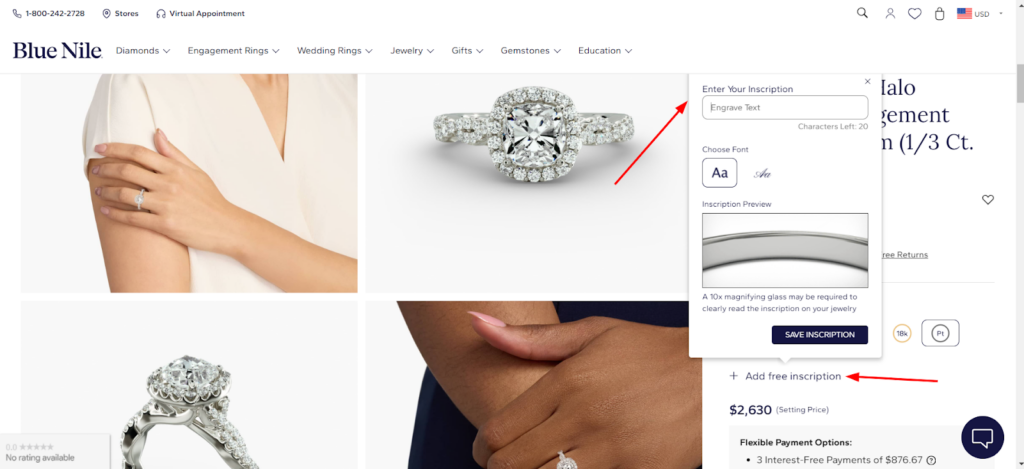
This is perfect for customers looking to create something one-of-a-kind, like an engagement ring or an anniversary gift. When shoppers have the chance to create something truly unique, it not only enhances their connection with the product but also gives them a sense of ownership.
Now they won’t like to leave the item they’ve invested time and effort personalizing it. As a result, the chances of conversion increases.
Key Takeaways:
- Make it easy for customers to find your customization options.
- Create a dedicated section or make it a key feature on each product page.
- Use an online tool that lets customers preview their personalized designs in real-time before finalizing their order.
7. Wow Them with High-Quality 360-Degree Product Views
I know, some brands take it as another ecommerce trend and let it go. However, every trend has some influence on shoppers and their buying decisions.
When they are buying jewelry online, they can’t feel the weight of a diamond ring or examine the greatness of a gemstone in person. So how do you give your shoppers the confidence to hit “Add to Cart”?
The question is—what’s the next best thing to holding a piece of jewelry in your hand? A 360-degree product view does exactly that! It allows your customers to inspect your pieces from every angle as if they were twirling it around in front of a mirror. It makes customers feel like they have control—they can zoom in, rotate, and see the tiniest details without relying on static images.
In fact, research shows that 360-degree product views can increase conversion rates by as much as 30%!
Brands like Blue Nile have implemented this. Their customers can rotate diamond rings to see every angle, inspect the sparkle, and get a real feel of how it looks on different hand models.
This experience builds trust and reduces hesitation, which is key when you’re asking someone to invest in luxury items like fine jewelry.
Key Takeaways:
- High-quality 360-degree images require proper tools and software. Opt for the tool that offers smooth image rotation and zoom functionality which makes each detail crystal clear.
- Jewelry, especially, needs great lighting to showcase the shine of diamonds or the intricate designs of metalwork. You want the view to be immersive—so that customers can almost feel the texture of the jewelry.
- Shoppers care about these small details, especially for high-end pieces. Don’t let any part of your jewelry go unnoticed.
8. Share Jewelry Care & Maintenance Tips
This is similar to how customers get a user manual that comes with any electronic product. Nowadays, clothing brands also include wash details and fabric care tips on their product pages to help shoppers with easy maintenance.
Gold, silver, and gemstones all need different care. Break it down for your customers. For example, explain how silver jewelry can tarnish over time and how polishing it regularly with a so
ft cloth can keep it shining.
You can offer them valuable care tips right on your product pages, or even better—include a care card with every purchase. These little details can go a long way in boosting customer confidence.
See how Kendra Scott offers jewelry care on their product page.

Key Takeaways:
- Add a ‘Jewelry Care Tips’ Section on your product pages that offers easy-to-follow advice specific to each type of jewelry.
- Include a Care Card with every jewelry purchase to ensure customers know how to maintain their items.
- Educate Customers on Preventative Care by reminding them to remove jewelry before applying lotions, perfumes, or engaging in strenuous activities.
- Create Seasonal Care Guides, educating customers on how to protect their jewelry during hot summers or cold winters.
- Create a Blog or Video Series with care and maintenance tips, and share these across your social media platforms.
Here are some ideas to increase the AOV of your jewelry store:
- Suggest Cleaning Kits and link to recommended products on your site that pair well with your jewelry collection.
- Offer a Jewelry Cleaning Service as an add-on to purchases, encouraging customers to come back for regular upkeep.
- Highlight Proper Storage Solutions and recommend jewelry boxes or pouches to help protect items from tarnish and wear.
9. Offer Various Custom Packaging Options
Unwrapping the product box is a fascinating experience. People are naturally drawn to things that feel personal and special.
Ask yourself: What impression do you want your customers to have when they unbox their purchase?
You can offer custom packaging options that add a personal touch, which can make your products stand out and create an emotional connection. From elegant boxes tied with ribbons to eco-friendly, minimalistic packaging, you can give customers a choice that suits their personal style and values. Plus, it’s one more reason why customers might choose your store over a competitor.
One of the best examples is Pandora! Customers can choose from different packaging options, including special gift wrapping and eco-friendly alternatives.
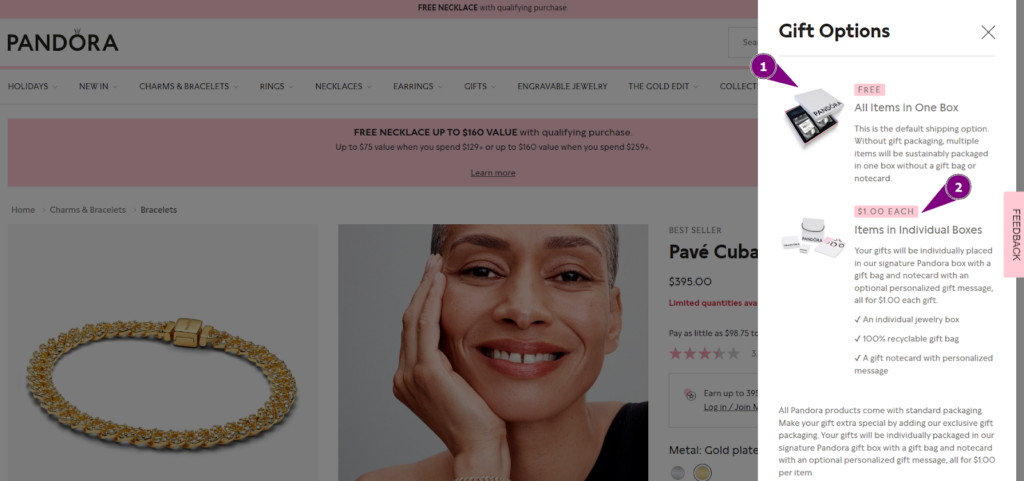
Many customers appreciate brands that care about the environment. You can consider offering eco-friendly packaging made from recycled or biodegradable materials, showing that your brand aligns with its values just like Pandora.
It creates a stronger emotional connection, which can increase loyalty and even lead to word-of-mouth recommendations.
Key Takeaways:
- Provide different levels of packaging, from simple elegant options to premium, high-end materials for an exclusive experience.
- Highlight the benefits of the various packaging options with clear additional charges shoppers need to pay.
10. Feature Seasonal or Occasion-Specific Collections
Special occasions like holidays, birthdays, and anniversaries are when people love to buy jewelry—especially as gifts. Whether it’s a necklace for Mother’s Day, a bracelet for a birthday, or a ring for a wedding anniversary, people are often searching for the perfect piece to match the moment.
One of the easiest ways to increase sales in your jewelry store is to offer collections that cater specifically to these occasions. When you offer curated collections for these occasions, you not only enhance the shopping experience but also increase the conversion rate.
So, how can you do this in your store?
The idea is simple: create collections for different seasons or celebrations. You could have a Valentine’s Day collection with heart-shaped necklaces or a graduation collection with elegant, professional pieces.
Here’s the best example of GIVA’s collection for Valentine’s Day sale.
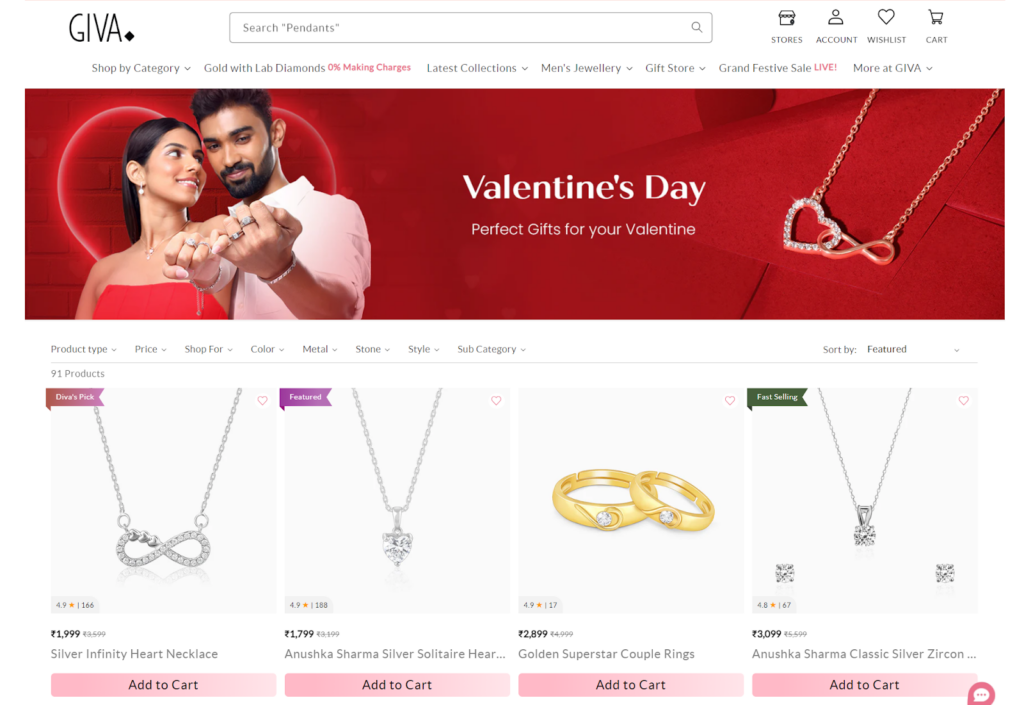
Adding small, thoughtful touches like special packaging or engraving options can also make a big difference in how personal the gift feels.
Key Takeaways:
- Determine the most significant events in your targeted region, such as holidays, anniversaries, birthdays, and graduations.
- Select pieces that align with the theme of the occasion and appeal to your target audience.
11. Promote Ethical Sourcing & Sustainability
People today care about where things come from. They want to feel confident that their jewelry doesn’t harm the environment or involve unfair labor practices. This is particularly true for luxury items like jewelry.
As a jewelry store, promoting ethical sourcing and sustainability can significantly enhance your brand’s reputation, attract eco-conscious customers, and ultimately increase conversions.
When you promote ethical sourcing and sustainability, you’re showing your customers that you care about more than just selling them a product—you care about making the world a better place.
A jewelry brand that’s really leading the way is Brilliant Earth. They’ve built a strong reputation by focusing on conflict-free diamonds and eco-friendly materials.
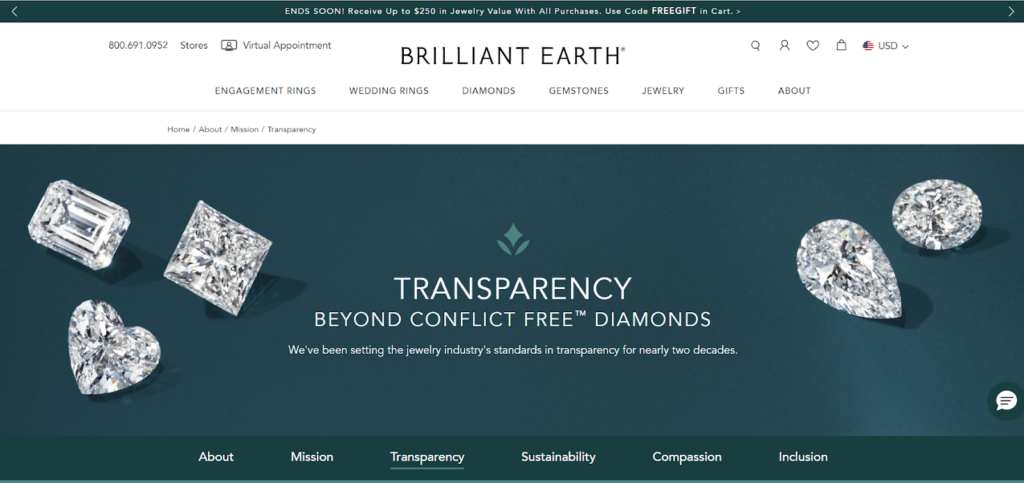
On their website, they explain their process clearly, so customers know they’re making a responsible choice.
Here’s how they’ve promoted this on their product page.

Key Takeaways:
- Promote jewelry made from recycled materials or ethical gems as part of your collection.
- Showcase certificates proving their ethical sourcing practices (like Fairtrade or RJC – Responsible Jewellery Council).
- Share behind-the-scenes content that highlights your ethical practices and the stories behind your jewelry.
12. Curate Gift Sets and Bundles
When customers come to your store, they often want something special but don’t know where to start. Finding a perfect gift is always tough — most of your shoppers would agree with this.
Ask yourself — can you take a step ahead to help them in gift selection? You can add a questionnaire to know their shopping purpose and then suggest a suitable selection.
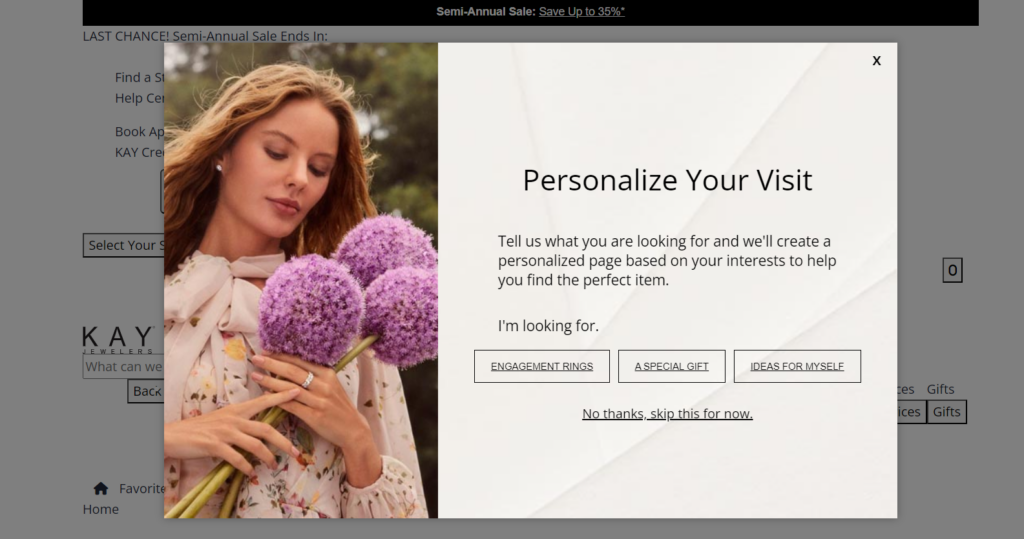
This can include curated gift sets and bundles. Or you can also allow them to create their bundle.
Look at Kendra Scott, for example. They have created curated gift sets that cater to various occasions.

Offering curated gift sets or bundles makes the shopping experience easier for your customers and more profitable for your store.
Key Takeaways:
- Create sets that fit the occasion so the shoppers don’t have to guess.
- Mix different types of jewelry together, like a necklace, a pair of earrings, and a bracelet. When the pieces match, it feels like a complete, polished gift.
- Offer a small discount when someone buys the set instead of buying each piece individually.
13. Incorporate Flexible Payment Options
Jewelry is often a big investment, and not everyone is comfortable paying the full price upfront.
Offering alternative payment methods like installments or buy now, pay later (BNPL)—makes your products more accessible. These services let customers break down large purchases into smaller, manageable chunks, often without any interest if paid on time.
And the best part? It doesn’t just benefit your customers—it helps you, too! Flexible payment options can increase your conversion rate by reducing the barrier to purchase.
With BNPL, customers can receive their jewelry immediately but delay full payment. This is especially useful during busy shopping seasons like the holidays when budgets are tight.
The best example of a luxury jewelry brand offering flexible payment options is Pandora. Known for its high-end jewelry, Pandora introduced installment payment plans to make their pieces more accessible.
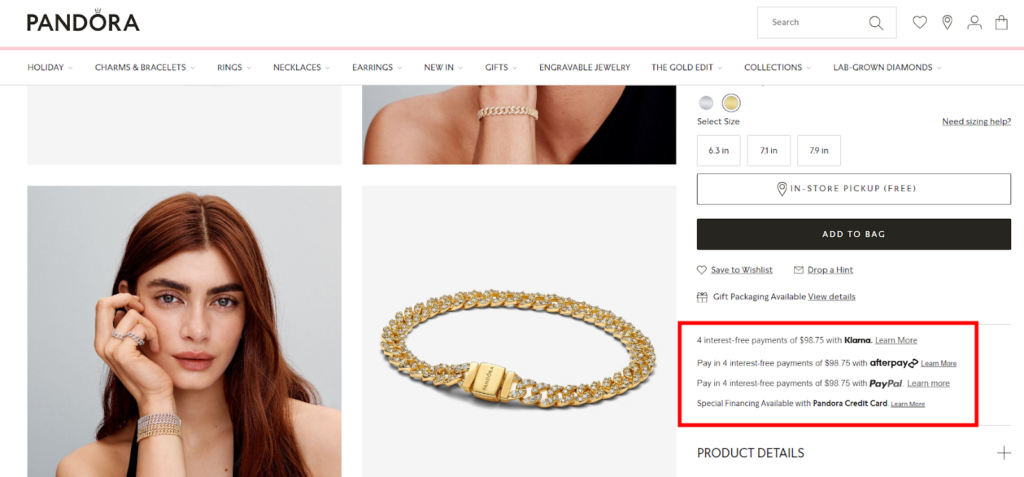
By offering flexible financing, they’ve allowed customers to enjoy their iconic jewelry without the pressure of paying in full upfront, and parallally increasing the conversions.
Key Takeaways:
- To get started, explore payment platforms like Klarna or Afterpay, and choose the one that best suits your business.
- Make sure customers see their payment options on product pages, cart pages, and during checkout.
- Include FAQs or blog posts explaining how financing works and its benefits for customers.
14. Offer Extended Warranty Programs
Customers want to feel secure about their purchase, especially with high-value items like jewelry. When you offer a warranty included in the purchase, you’re giving your customers extra confidence that their jewelry will be taken care of, even if something unexpected happens.
Every jewelry store typically offers some kind of included warranty with each purchase. This might cover basic repairs or defects for a limited time, say six months or a year. It’s a nice perk, but it’s limited.
However, the extended warranty is a little different. It goes beyond that initial coverage. It offers longer protection, often several years or even a lifetime, and covers more than just defects.

An extended warranty builds trust because it shows that you stand behind the quality of your jewelry. It also reassures customers that even if something goes wrong, they won’t be stuck with a hefty repair bill. That peace of mind is often the extra nudge people need to make their purchases.
To understand the difference better, we’ve given two examples where you can find how both the initial warranty and extended warranty look like.
Some popular jewelry brands like BRUNA offer an initial warranty (here 1-year warranty) to their customers. See how they’ve mentioned it in the key highlights.
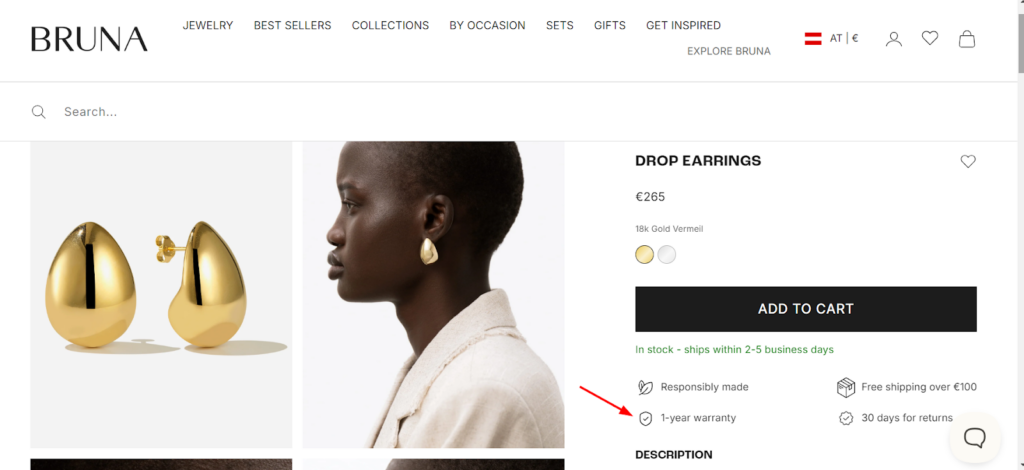
On the other hand, some jewelry brands provide extended warranties. Take Kay Jewelers, for example. They’ve built customer trust by offering a “Lifetime Jewelry protection plan”.
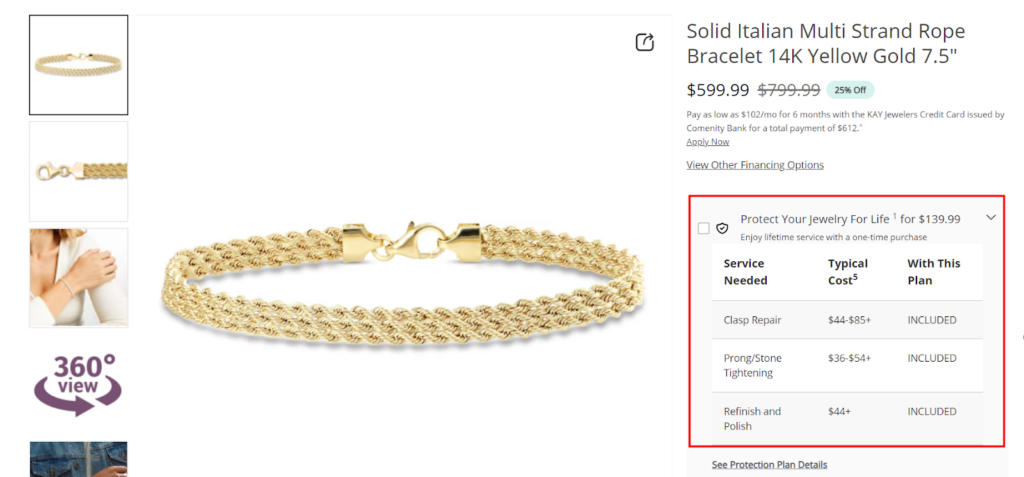
It covers things like tightening loose stones and routine maintenance, so customers feel secure knowing their jewelry is in good hands for life.
Key Takeaways:
- Some customers might just want a couple of years of extra protection, while others may prefer lifetime coverage. Offer different plans so everyone can choose what works best for them.
- Break down the difference between the included warranty and the extended one in simple terms. Make sure your customers understand what’s covered.
15. Show Approx. When the Order will be Delivered
When people shop for jewelry, especially for gifts or special events, knowing the estimated delivery date can make all the difference. It’s often the deciding factor in whether they complete the purchase.
After all, if customers are uncertain about when their order will arrive, they may hesitate to hit that “buy” button.
On the other hand, when they know exactly when they’ll get their order, they’re much more likely to go ahead with the purchase. It’s because they feel confident that they’ll get their jewelry on time.
Let’s take a look at the example below. Blue Nile has displayed the exact delivery date right on the product page.

It gives the customer an idea of when they can expect to receive their order, and they can decide whether to place an order or not.
Key Takeaways:
- Show estimated delivery times on each product page, so customers know when to expect their order before they add items to the cart.
- Reiterate the delivery timeline during checkout to reassure customers before they complete the purchase.
- Give customers flexibility by offering standard, express, and next-day delivery options, each with clear timelines.
- If you ship internationally, display estimated delivery times specific to each country to avoid confusion.
- For local customers, you can offer in-store pickup or same-day delivery as fast alternatives to standard shipping.
We’ve covered 15 powerful strategies to boost conversions for your jewelry store, but you might still have a few questions on your mind. That’s perfectly normal!
Let’s resolve them in the next section.
FAQs on Jewelry Store Conversions
To help you get even more clarity, here are some commonly asked questions we receive about increasing jewelry store conversions—along with clear, actionable answers.
What is a good conversion rate for jewelry?
A good conversion rate for a jewelry store typically ranges between 1% and 3%. However, top-performing stores can achieve 3% to 5% or even higher. The key is to focus on continuous improvements, like enhancing your product pages, offering great customer service, and using conversion-boosting strategies like the ones we discussed earlier.
How to increase jewelry sales online?
To increase jewelry sales online, you can focus on creating a user-friendly website with detailed product descriptions, high-quality images, and clear calls-to-action. Additionally, you should offer personalized options, flexible payment plans, and ensure a smooth checkout process. You can also leverage social proof, limited-edition collections, and ethical sourcing to attract more customers.
What type of jewelry sells best?
The best-selling jewelry often depends on trends and target demographics. Generally, personalized jewelry, engagement rings, and timeless pieces like gold and diamond earrings tend to be consistent top-sellers. However, fashion jewelry, ethical and sustainable pieces, and customizable options are growing in popularity, especially with younger audiences.
How to find jewelry customers?
You can find jewelry customers through a combination of online and offline marketing efforts. Use social media platforms like Instagram, Pinterest, and Facebook to showcase your collections. Collaborating with influencers, running targeted ads, and offering promotions can help draw attention to your store. Additionally, attending local events, markets, or trade shows can build your customer base.
Is selling jewelry online profitable?
Yes, selling jewelry online can be highly profitable if done right. Profitability depends on factors like product quality, pricing, marketing efforts, and customer experience. With low overhead costs (compared to physical stores) and a growing global market for online jewelry, there’s significant potential to earn a healthy profit. For that you should focus on offering unique value, standing out in a crowded market, and keeping your operations efficient to maximize profitability.
Final Thoughts!
So finally, we come to the end here. Hope all these strategies will help you boost your jewelry store conversion rate.
After years of eCommerce experience, we realized that every small detail has a great impact on the user experience. And the more you focus on improving the shopping experience for your customers, the more you improve your conversion rate. It’s all about understanding what your customers need at each step of their journey and delivering it with a seamless experience.
If you’re looking to take your store’s performance to the next level, the right design and user experience can make a world of difference. A well-optimized, conversion-focused design ensures that every touchpoint—whether it’s product pages, checkout, or customer support—is geared toward driving more sales.
Feel free to reach out if you’d like expert help in creating a user-friendly, conversion-focused design tailored to your jewelry store—Free Consultation Call with Experts!
After all, a great design isn’t just about aesthetics—it’s about driving real results.






Post a Comment
Got a question? Have a feedback? Please feel free to leave your ideas, opinions, and questions in the comments section of our post! ❤️